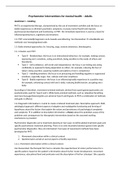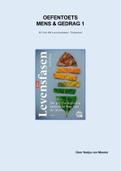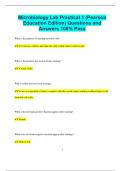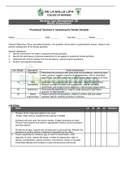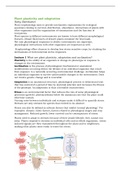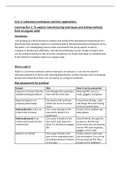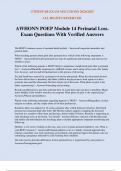Hoofdstuk 1 - Inleiding:
PMT is an experiential therapy, characterized by the use of movement activities and the focus on
bodily experiences to diminish psychiatric symptoms, increase mental health and improve
psychosocial development and functioning. In PMT, the immediate experience is used as a basis for
influencing behaviours, cognitions and emotions.
1.2. PMT voornamelijk begonnen na de tweede wereldoorlog. Van Roozendaal ontwikkelde een
methode voor bewegingsobservatie.
1.3. Body oriented approaches: bv. focusing, yoga, sensory awareness, bioenergetics.
1.4. 4 doelen voor PMT:
Type R – Relationships: the focus is on interactional behaviour, for example, making contact,
expressing one’s emotions, acting assertively, being sensitive to the needs of others and
boundaries.
Type S – Self confidence, self worth and independence: the focus is on feeling and acting
confidently as opposed to being dependent on others, for example, reducing the fear of
failure, being assertive, acquiring realistic perceptions of one’s competence
Type E – Handling emotions: the focus is on processing and handling negative or suppressed
emotions, especially anger, fear, sadness and inner emptiness
Type B – Bodily experience: the focus is on influencing bodily experience in a positive way,
for example, enhancing contact with one’s body, reducing bodily tension, accepting one’s
body.
According to Fahrenfort, movement-oriented methods, derived from sport/games/gymnastics are
predominantly used for Type R and S. While body-oriented methods, such as relaxation/breathing
exercises/massage/bioenergetics are aimed at Type E and B goals. In PMT a combination of methods
and goals is offered.
1.6. Diagnostic information is crucial to create a tailored treatment plan. Descriptive approach: DSM,
aetiological approach: different aspects of adaptive and maladaptive functioning and forming of
hypotheses about the factors that explain the nature and persistence of psychological complaints
and symptoms in addition to descriptive information: a theory about the potential causes of the
problems and consequences for therapeutic interventions based on the assumed working
mechanisms is provided.
Psychomotor diagnostics serve treatment planning in two ways: to define global treatment goals and
specific psychomotor treatment planning. There is no strict boundary between general and specific
psychomotor diagnostics; they are intertwined. Two types of assessment methods have been
developed for PMT:
1. Movement observation within a clinical context
2. Questionnaires aimed at several aspects of bodily experience
1.6.1. Movement observation within a clinical context:
Van Roozendaal: the therapist first has to calculate the expected level of motor performance for a
specific patient, based on the patient’s information about his/her motor development, movement
experiences, educational level and profession and the description of his/her ‘physique’ (the capacity
,to perform movement). Next, the patient is invited to participate in activities derived from sports and
physical education (basketball, running, balance). The therapist then scores the actual level op motor
performance, which is compared with the expected level to calculate the so-called motor percentage.
Van Roozendaal provides an extensive list of descriptions to characterize the dominant aspect of a
patient’s expressive psychomotor behaviours: tense; inhibited; impulsive; lanky; bizarre; anxious;
feminine; infantile; indifferent. After completing the observation of movement, the therapist writes a
report about the patient where indications and goals for therapy are detailed.
Gordijn et al. + Diepenhort and Van der Klis: movement features that colour the ‘movement
dialogue’ of the patient and his environment; this strongly relates to Van Roozendaal’s expressive
aspects
LOVIPT scale: 9 categories that are directly related to goals for PMT: (1) relationships; (2) self-
esteem; (3) being active; (4) being relaxed; (5) movement control; (6) being focused in situations; (7)
expression in movement; (8) verbal communication; (9) regulation. The complete assessment takes a
minimum of five sessions (group or one-to-one).
Kuin: jumping on a trampline never validated
Specific populations:
- PMDI: trauma
- Gedragsobservatieschaal psychomotorische therapie voor demente ouderen
1.6.2.1. Dimensions of bodily experience
Recent classifications of the domains of bodily experience are unanimous in including the following
domains:
1. Body attitude: referring to cognitive, affective and behavioural attitudes towards the body
2. Body satisfaction: defined as the degree of contentment with appearance or functionality of
the body
3. Body awareness: the perception of bodily states, processes and actions presumed to
originate from sensory, proprioceptive and interoceptive afferents that an individual has the
capacity to be aware of.
Questionnaires:
- Body attitude: The Dresden Body Image Questionnaire (DBIQ): 35-item questionnaire with
positively and negatively worded statements across five sub-scales: body acceptance, vitality,
physical contact, sexual fulfilment, self-aggrandisement. Scales from 1 = not at all, to 5 = fully
- Body satisfaction: The body Cathexis Scale: 40-item self-report measure. The items relate to
satisfaction with the body or bodily functions (hands, vitality, eyes, health). 5 point scale: 1 =
very dissatisfied, 5 = very satisfied.
- Body awareness:
o Somatic Awareness Questionnaire (SAQ): body awareness here is defined as the
tendency to be aware of or sensitive to internal bodily processes and states not
typically associated with illness or emotion. 25-item self-report that assesses
sensitivity to and awareness of internal bodily signals and states (energy level,
tiredness awareness). 5-point scale: 1 = not at all, 2 = barely, …, 5 = much).
o Scale of Body connection (SBC): two subscales: body awareness (12 items) and body
dissociation (8 items).
, o Multidimensional Assessment of Interoceptive Awareness (MAIA): was developed
with the aim to measure different modes of interoceptive awareness. 32-items on a
6-point Likert scale. 8 subscales: (1) noticing the awareness of one’s body sensations;
(2) not-distracting, the tendency not to ignore or distract oneself from sensations of
pain or discomfort; (3) not-worrying, the tendency not to experience emotional
distress or worry with sensations of pain or discomfort; (4) attention regulation; (5)
emotional awareness; (6) self-regulation; (7) body listening; (8) trusting
1.7. Action oriented PMT: aimed at supporting personal development from a learning perspective
activities and exercises where a patient can practice or train certain skills (learning to relax muscles,
better physical condition by taking part in a running programme).
Experience oriented PMT: aimed at offering an alternative frame of experiences, by inviting patients
to engage in movement- and body-oriented exercise that elicit sensations, emotions, cognitions and
behaviour. The therapist may choose a non-directive, person-centred approach to focus on the
awareness of subjective experiences, or a more dynamic confronting style to help develop better
insight into inter- and intrapsychic conflicts.
1.7.1. Mono-methods:
Physical education- and sports-based practice
- Physical education based PMT: usually offered within group therapy settings, to enable social
interaction. Context manipulation is a central concept (social and material).
- Exercise-based therapy: influences mental health in a positive way by using cardiorespiratory
or muscle strengthening exercises, bv. Running therapy: 12-week programme, 3
sessions/week, 1 hour, running at 60-80% of one’s VO2max. Therapist participates!!
Relaxation therapy
- SensoRelaxation: to become aware of and reduce non-adaptive high levels of muscular
tension. The method is characterized by the use of physical contact and physical and verbal
communication between therapist and patient. Therapist uses tactile and kinaesthetic
information.
- Progressive and applied relaxation: contract and release different muscle groups. Patients
practice tensing a muscle group until they recognize the feeling of event he slightest
contraction, and then learn to release it. Applied relaxation: making relaxation a portable skill
to be used when anxiety is encountered in natural settings.
- Autogenic training: also known as self-hypnosis and is aimed at developing inner calm by
using specific affirmations and concentrating on specific parts of the body or breathing.
- Breathing and relaxation therapy: Adem- en ontspanningstherapie. Attention is paid to
matching the type of intervention with the patient; continuous adaptation of the techniques
guarantees its personalized characteristics.
Methods aimed at improving body awareness
- Alexander: aims at discovering patterns of habitual tension. Core principle: ‘use affects
function’: what we do with ourselves in daily life and during any activity that is repeated over
and over again affects us in a fundamental way. The technique teaches in individual lessons
how to bring more awareness into one’s ‘use’ and develop a sense of choice to react
differently.
, - Feldenkrais: uses gentle touch, movement and the direction of attention to increase
awareness of the body and facilitate easy, fluid movement and balance. The lessons attempt
to make individuals aware of their habitual neuromuscular patterns and rigidities and to
expand the habitual repertoire with new options while increasing sensitivity and improving
efficiency.
- Sensory awareness: the training is experiential and aims at balancing autonomy with external
support. one may experience human support not as a reduction of autonomy, but as a
deeply nourishing connectedness with others, an essential antidote to feelings of isolation
and stress.
- Focusing: developing the ability to become aware of one’s bodily feelings associated with
mental functioning, the ‘felt-sense’. 6 steps to learn to focus on the felt-sense: clearing a
space; felt-sense; handle; resonating; asking; and receiving.
- Yoga: an embodying activity that promotes body awareness, connection and responsiveness,
as well as appreciation of body functionality.
Inner experiences and expressive action
- Bioenergetics: aimed at breaking through the blocks of muscle tension patterns that are
supposed to represent specific emotional traumas or conflicts, using physical and expressive
exercises and palpation techniques to free a person’s energy.
- Action therapy: the therapist creates a metaphor that represents the problem. This
metaphor may be visualized or expressed bodily, with the help of objects. In this procedure,
the therapist listens carefully and actively to the problem presented and then shares his/her
observations, followed by an invitation to take part in an experiment where an action
method is applied.
- Pesso Boyden System Psychomotor: developed an interactive model that drew on spatial
relationships, specific wording and physical touch to provide a response from the outer
world to each of the inner needs that are expressed.
Movement interventions derived from or based on martial arts
Boxing, kick-boxing, Tai chi, aikido, chi kung, judo. The goals are often related to resilience,
empowerment or assertiveness, but the emphasis may also be on body awareness.
1.8. Integration: current clinical theories and practices
Any form of therapy should have a structural and logically consistent framework:
1. Meta-theory: a general, large scale ‘background theory’ such as an anthropolocial theory
2. Middle-range theories: clinical theories such as personality theory, developmental theory,
psychopathology, theory of therapy
3. Praxeology: small-range theories such as the theory of interventions, methods, techniques,
process theory
4. Practice: concrete interventions
1.8.1. Beyond dualism: paradigms for PMT
Phenomenology:
Studies the structures of human experience and consciousness. Merleau-Ponty criticized the theory
of mind-body dualism, where mind and body are distinct kinds of substances. In this view, the body is



